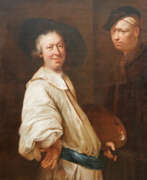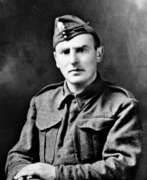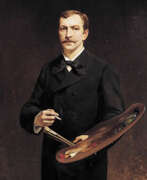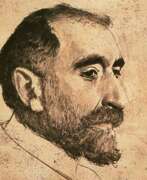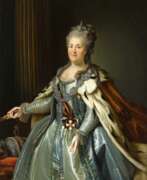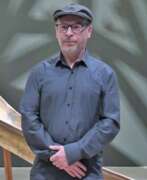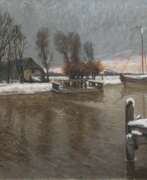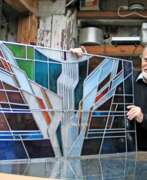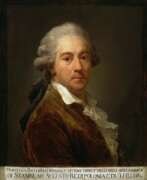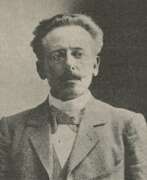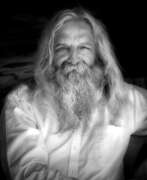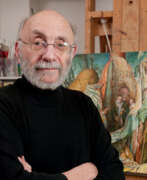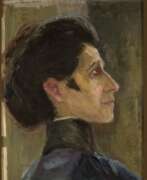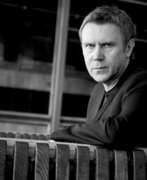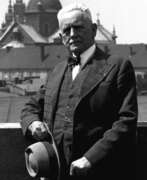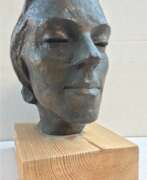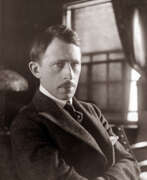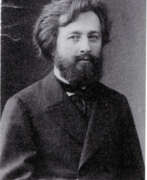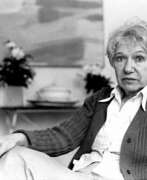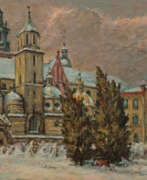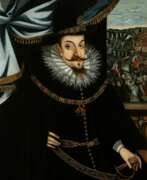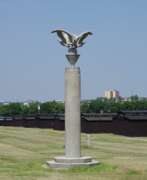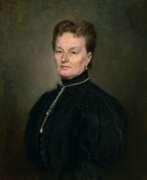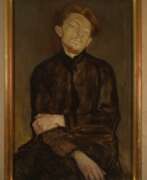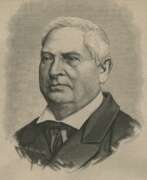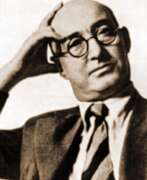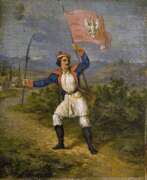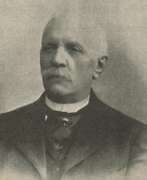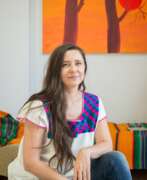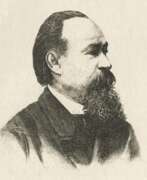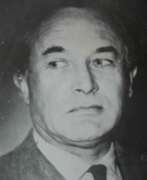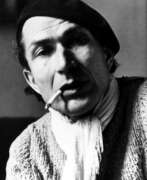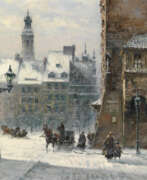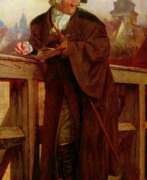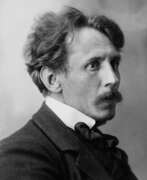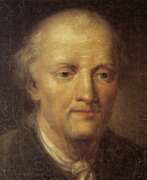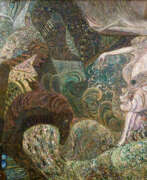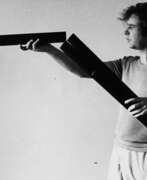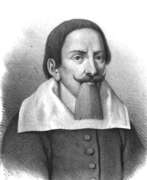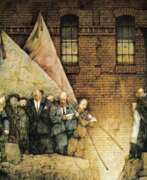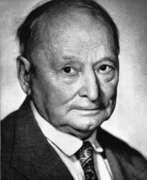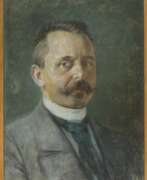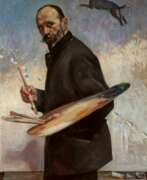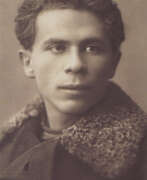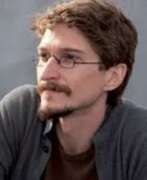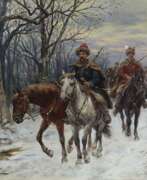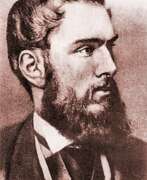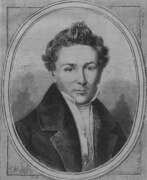Artists Poland
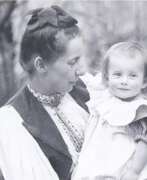

Jenny Fikentscher (born Nottebohm) was a German painter and graphic artist associated with the Art Nouveau movement. She studied at the School of Women Painters in Karlsruhe and later became part of the Grötzingen artist colony. Fikentscher married animal painter Otto Fikentscher and raised five children in an unconventional artistic household. She was known for her botanical motifs and lithographs, often featuring local plants. Fikentscher also created collectible images for the Stollwerck chocolate company.
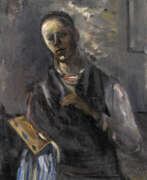

Alfred Aberdam was a Polish painter associated with the School of Paris, known for his participation in the artistic movements of the early 20th century. Born in Lviv, then part of the Austro-Hungarian Empire, Aberdam's journey in the arts began with his studies at the Munich Academy in 1911. His life and work were marked by significant historical events, including imprisonment during World War I and an active period in Poland's art scene before settling in Paris. Aberdam's contributions are remembered through his numerous exhibitions, including solo showcases in Paris, London, and Tel-Aviv, as well as posthumous retrospectives like the one in Geneva's Petit Palais in 1970.
Aberdam's works reflect the cultural dynamism of the School of Paris, capturing a confluence of influences that characterized the European art scene. Despite being somewhat lesser-known, his paintings have been traded at auction, reflecting a continued interest and recognition of his artistic legacy. His art remains an important part of the narrative of Jewish painters in Paris from 1905 to 1939, contributing to our understanding of the era's artistic diversity.
For collectors and experts in art and antiques, Aberdam's work embodies the intricate history and cultural exchanges of the early 20th century European art world. His paintings not only represent his individual talent but also tell the story of the times in which he lived, worked, and created. Understanding Aberdam's art is a journey through the cultural melting pot that was Paris during a pivotal period in modern art history.
For those interested in exploring the legacy and works of Alfred Aberdam further, or seeking to keep abreast of new product sales and auction events related to his work, subscribing for updates is invaluable. Stay informed on the latest developments and opportunities to appreciate or acquire pieces by this notable artist. Subscribe now to ensure you are alerted to new sales and auction events featuring the esteemed Alfred Aberdam.


Kazimierz Alchimowicz was a Polish painter who is considered one of the last Romantics in Polish painting. Among other things, he illustrated Adam Mickiewicz's poem Pan Tadeusz with a series of twelve paintings (1898) and prints (1903). He was the elder brother of the Polish painter Hiacynt Alchimowicz.
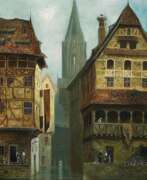

Robert Assmus is a German landscape artist and illustrator. He took lessons from the floral artist Friedrich Wilhelm Völker. He devoted himself entirely to landscape painting, earning a living by illustrating for the newspapers Illustrirte Zeitung, Die Gartenlaube, Daheim magazine and other publications. After the end of the Franco-Prussian War of 1870-1871, he undertook study trips to northern Italy, the Carpathians, Hungary, the Baltic Sea and Switzerland. Inspired by what he saw, he published a magnificent illustrated work, the album “Alsace-Lorraine,” which received positive reviews from the public.


Abraham Adolf Behrman was a Polish artist of Jewish origin, best known for his paintings of Jewish shtetl life in the open air as well as landscapes and group portraits. He spent most of his life in Łódź and was killed during the liquidation of the Białystok ghetto during the Holocaust.
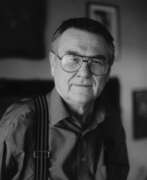

Zdzisław Beksiński was a Polish painter, photographer, and sculptor, specializing in the field of dystopian surrealism.
Beksiński made his paintings and drawings in what he called either a Baroque or a Gothic manner. His creations were made mainly in two periods. The first period of work is generally considered to contain expressionistic color, with a strong style of «utopian realism» and surreal architecture, like a doomsday scenario. The second period contained more abstract style, with the main features of formalism.
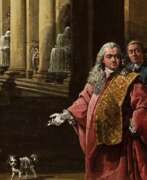

Bernardo Bellotto was an Italian painter, celebrated for his urban landscapes and detailed vedute, particularly of European cities like Dresden, Vienna, and Warsaw. He was born in Venice in 1722 and exhibited prodigious talent from a young age. Under the tutelage of his uncle, the renowned Canaletto, Bellotto honed his skills in capturing the essence of cityscapes with a unique style characterized by a cooler palette and a distinct use of impasto, especially in depicting skies and horizon lines.
In 1747, Bernardo Bellotto's career took him to Dresden, where he served as Court Painter to Augustus III of Poland and Elector of Saxony. His stay in Dresden was marked by the creation of panoramic views, highlighting his knack for architectural detail and the interplay of light and shadow. Following his tenure in Dresden, Bellotto spent the last 16 years of his life in Warsaw, where his works played a significant role in the city's post-World War II reconstruction.
Bernardo Bellotto's works are lauded for their precision and the manner in which they blend his Venetian roots with influences from Dutch landscape painting. His later works in Warsaw, characterized by their vibrant color palette and historical themes, underscore his evolution as an artist. Today, Bellotto's paintings are celebrated for their historical value and artistic merit, housed in prestigious collections in cities like Dresden and Warsaw.
For those interested in exploring the fascinating world of Bellotto's art and its impact on European cultural heritage, signing up for updates on new product sales and auction events related to Bernardo Bellotto is an excellent way to stay informed.
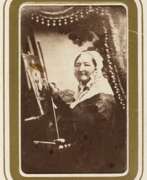

Henryka Zofia Maria Beyer was a German-Polish artist of the first half of the 19th century. She is known as a painter and graphic artist.
Henryka Beyer moved to Warsaw from Berlin early in her career. She worked in oil, watercolor and gouache. The artist preferred to paint still lifes with flowers and fruits in warm, dark colors, creating them in the style of Dutch artists of the 17th and 18th centuries and using mostly watercolors. She signed her works as Hka Beyer.
Beyer established the first painting school for women in Poland.


Józef Brandt was a Polish battlefield painter.
After changing his mind about becoming an engineer, in 1862 the aspiring artist moved to Munich, where he studied under Franz Adam and Karl Piloti, and eventually opened his own studio. Brandt was recognized in Munich as one of the outstanding artists of the Polish school; he quickly achieved both financial and artistic success here, and his studio attracted many pupils. By 1875 he was running an informal school for young artists, most of whom were Polish, and in the same year he was elected a member of the Berlin Academy. In 1878 he was elected a member of the Munich Academy, and in 1900. - Prague Academy.
The main theme of Brandt's work is scenes of the 17th-century wars in Poland, the Tatar and Swedish invasions. He accurately depicted the ammunition, arms and equipment of their participants and was especially fond of drawing horses.
Józef Brandt's paintings are in almost all Polish museums, and he is represented in museums and private collections in North America and Europe.
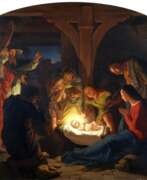

Albrecht Peter Bräuer was a German painter and draftsman, from 1860 a teacher at the School of Applied Arts in Breslau. Paintings for various places of worship, Bräuer soon made a name for himself as a church and history painter. In addition to this painting, he produced materials for art classes, such as templates for drawing classes, an ornamental work with 40 lithographs, which won a gold medal at a Berlin exhibition in 1878. He also copied works by old masters. He also engaged in experiments on dyes and art-theoretical research on perspective, anatomy and proportions. In addition, he collected engravings and drawings depicting garments, art objects from different times and cultures, as well as folders with ornamental, plant, perspective and anatomical studies for his studio at the art school.


Szymon Buchbinder was a Polish painter of the late nineteenth and early twentieth centuries of Jewish origin. He is known as a genre painter and portraitist.
Szymon Buchbinder created genre-historical paintings, often with moral overtones, as well as portraits executed in small formats. Many of the subjects were related to Jewish culture and customs. The style of Buchbinder's painting is considered by critics to be in the tradition of the old Dutch school of painting.


Fyodor Fyodorovich Buchholz (Russian: Фёдор Фёдорович Бухгольц) was a Russian artist of German origin in the late 19th century and the first half of the 20th century. He is known as a painter, graphic artist and teacher.
Fyodor Buchholz painted mainly on historical themes and genre paintings, as well as portraits and landscapes. At the end of the XIX century, the artist was fascinated by Art Nouveau. After the revolution of 1917 he began to create works on the themes of social construction.


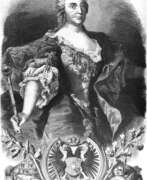

Georg Conrad Ludwig Burger was a German historical painter, illustrator, and medallist. He studied at the Berlin Art Academy, at the same time working at book illustrating; he was also a pupil of Thomas Couture in Paris. Among his best drawings are the illustrations for the works of La Fontaine and a collection of 20 plates known as Die Kanone. After 1869, he devoted himself to decorative painting, his most important work in this line being the walls and ceilings in the Berlin City Hall (1870) and the colossal figures symbolizing the warlike virtues at the School of Cadets at Lichterfelde (1878).


Pinchas Burstein, better known as Maryan S. Maryan, was a Polish-born Jewish post-expressionist painter.
Maryan created colourful, atmospheric paintings that combined elements of abstraction and figuration. His works were richly coloured and used unusual materials such as glass and metal. He was known for his experiments with shapes and colours as well as his unusual technical approach to painting. Maryan S. Maryan was one of the founders of the Post-Expressionist movement and made an important contribution to the development of modern art.
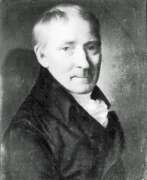

Daniel Caffé was a distinguished German pastel painter of portraits. Known for his meticulous craftsmanship and the emotive depth of his portraiture, Caffé initially embarked on a career in architectural decoration before his talents led him to Dresden to become a portrait artist.
Daniel Caffé's journey into the world of fine arts was marked by his study at the Dresden Academy of Fine Arts under the guidance of significant figures like Casanova and the influence of neoclassical artist Anton Raphael Mengs. His mastery of pastel made him a favored portraitist among the nobility and notable figures of his time, including Russian patrons like Prince Beloselski and Admiral Fyodor Grigoryevich Orloff.
His works, celebrated for their detailed and expressive nature, capture the essence of his subjects with striking realism and emotional depth. Among his notable works are portraits of prominent individuals such as Johann George Tromlitz and Karl August von Hardenberg, which not only exemplify his skill but also his contribution to the documentation of his era's influential figures.
Daniel Caffé's legacy as a pastel painter is preserved in various art collections and continues to be admired for its historical significance and artistic merit. He passed away on January 16, 1815, in Leipzig, leaving behind a body of work that continues to be studied and revered in the art community.
For collectors and experts in art and antiques, Daniel Caffé's portraits offer a glimpse into the refined pastel techniques and cultural narratives of the late 18th to early 19th century. His works remain a significant part of German art history, celebrated for their contribution to the development of portrait painting.
To explore more about Daniel Caffé’s life and works, consider signing up for updates on exhibitions and auctions where his art is featured. This will provide opportunities to engage more deeply with the legacy of this notable artist.
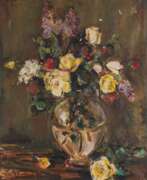

Stanisław Wincenty Chlebowski is a Polish impressionist painter and illustrator. His main themes are still lifes, floral compositions, genre scenes and landscapes, in particular views of Gdańsk and its surroundings. His paintings are in the collections of the National Museum in Gdańsk and the National Maritime Museum in Gdańsk.


Stanisław Chlebowski was a Polish orientalist painter.
His travels in the Middle East and North Africa, where he lived and worked for many years, had a great influence on Chlebowski's work. His paintings often feature scenes of daily life in these regions, including depictions of markets, street scenes, and traditional clothing.
Today, Chlebowski's paintings can be found in many public and private collections, including the National Museum in Warsaw and the National Museum in Krakow.
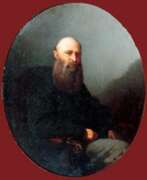

Romuald Chojnacki was a mid-nineteenth-century Russian artist of Polish descent. He is known as a painter and teacher.
Romuald Chojnacki was a follower of the Italian school of painting. He worked mainly in portrait and religious genres. At the beginning of his career, he also created historical paintings and returned to this genre shortly before his death.
The master was one of the founders of the Odessa Drawing School. Among his pupils was the famous Polish artist Stanisław Chlebowski.
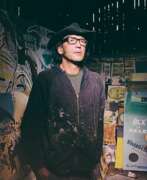

Andrzej Cisowski is a Polish multimedia artist and graphic artist.
Cisowski graduated from the Academy of Fine Arts in Warsaw and was initially associated with the Neue Wilde movement (Neo-Fauvism). Over time he developed his own individual style on the border of figurative painting and new expression. The artist also created paintings based on old photographs.
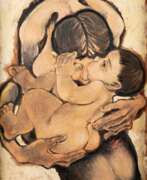

Hanna Dąbkowska-Skriabin is a Polish artist.
She graduated from the Academy of Fine Arts in Warsaw in the Department of Painting.
Hanna was very concerned about the fate of the human race, which is ruining itself with greed and short-sightedness. This is reflected in the works of the artist: many of her paintings are a timeless vision of a harsh world dominated by suffering and injustice. As if to protest against all this evil, Hanna Dąbkowska-Skriabin painted both paintings about love and beautiful landscapes. She is best known for her oil paintings. She has also mastered the techniques of ceramics and tapestry.
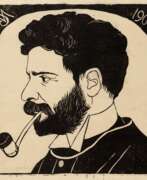

Samuel Jessurun de Mesquita was a Dutch graphic artist, born on June 6, 1868, in Amsterdam, into a Sephardic Jewish family. He became well-known for his contributions to graphic art, especially in the years leading up to the Second World War, and was notable for his mentorship of the famed artist M. C. Escher. De Mesquita's work was characterized by a variety of techniques and mediums, including wood engravings, etchings, lithographs, watercolors, and drawings. His art often featured birds, exotic animals, plants, flowers, and fantastical elements, both humorous and grim, showcasing his deep experimentation and mastery over his craft.
His career took a significant turn around 1915 when he began to gain prominence within Dutch graphic art, partly due to his teaching positions in the field. De Mesquita's penchant for experimentation led him to explore various materials for his prints, such as marble and zinc, and he often processed his prints with other materials, resulting in unique artworks. His subjects ranged from his immediate surroundings, such as his own home or the Artis zoo in Amsterdam, to more experimental and imaginative works that included quasi-human figures and fantastical landscapes.
Unfortunately, de Mesquita's life and career were tragically cut short by the Holocaust. Despite friends urging him to go into hiding, Samuel and his wife believed their Sephardic heritage would protect them. This proved to be a fatal miscalculation, and on January 31, 1944, they were arrested by the Nazis and subsequently died in Auschwitz. Their son Jaap died in Theresienstadt in March of the same year. M.C. Escher, a former pupil and friend, managed to save some of de Mesquita's works after his death, preserving his legacy for future generations.
Samuel Jessurun de Mesquita's body of work is a testament to his skill and creativity, with his pieces held in collections like the Kunstmuseum Den Haag and The Metropolitan Museum of Art. His works range from serene and simple depictions of animals and plants to more complex and imaginative 'Sensitivist' drawings that evoked a unique world from the artist's imagination.
For collectors and experts in art and antiques, de Mesquita's work offers a unique insight into the rich tradition of Dutch graphic arts and the avant-garde experiments of the early 20th century. His influence, particularly on M.C. Escher, highlights his importance in the development of graphic arts. Sign up for updates related to Samuel Jessurun de Mesquita to stay informed about new product sales and auction events showcasing his remarkable works.


Nejad Devrim, full name Mehmed Melih Nejad Devrim, is a Turkish-born artist who has lived and worked in France and Poland.
He was born in Istanbul to a family of writer and artist. In the 1940s, he entered the Istanbul Academy of Fine Arts, where he specialized in Byzantine mosaics and Turkish calligraphy. In the mid-1940s he went to Paris, where he actively participated in the local artistic life and maintained close relations with Pablo Picasso, Sonia Delaunay, Gertrude Stein, Tristan Zara.
He was the first Turkish artist to hold a solo exhibition of abstract art in Paris in March 1947 and is recognized as one of the most outstanding artists of the Paris School. In the 1950s, the October group, led by Nejad Devrim, launched the direction of abstract expressionism. His work was noticed and appreciated, already in 1958 he had a large retrospective exhibition in Brussels. He also exhibited his work in New York, Copenhagen, Vienna and Beijing. In the 1960s, he came to Poland to join his wife and settled in Nowy Sącz for the rest of his life. Nejad Devrim's works are in many European museums and private collections.
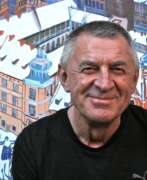

Edward Dwurnik was a Polish expressionist painter and graphic artist. Between 1963-1970 he studied painting, drawing and sculpture at the Academy of Fine Arts in Warsaw. He quickly became one of the most important figures of the Polish contemporary art scene.
Edward Dwurnik is best known for his large-scale paintings depicting everyday life, cityscapes and crowds of people. He often used bold, bright colours and strong black outlines to create his distinctive style. Many of his works depict the absurdity and contradictions of modern life in Poland and the struggles of ordinary people against political oppression and social injustice.
Throughout his career, Dwurnik's art has evolved and diversified, covering a wide range of techniques and themes. In addition to painting, he also worked in printmaking and drawing.
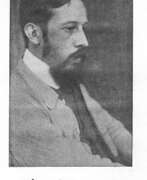

Fritz Helmuth Ehmcke was a German graphical designer, typographer and illustrator. Ehmcke was educated as a lithographer in Berlin during 1893–1897. In 1900, he was a co-founder of Steglitzer Werkstatt. From 1903, he taught at the Kunstgewerbeschule in Düsseldorf, from 1913 to 1938 in Munich, during 1920-1921 also in Zürich. During 1946 to 1948, he was professor at the Academy of Fine Arts, Munich. He designed a number of typesets, notably Ehmcke-Antiqua and Ehmcke-Kursiv in 1909/10 (adopted for English-language typesetting by Stephenson Blake under the name Carlton).
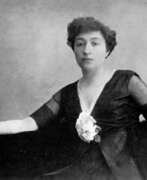

Aleksandra Aleksandrovna Ekster (Russian: Алекса́ндра Алекса́ндровна Эксте́р), a luminary of the Russian avant-garde, was a painter and designer whose work traversed the boundaries of Cubo-Futurism, Suprematism, and Constructivism, eventually influencing the Art Deco movement. Born in Białystok (then part of the Russian Empire, now Poland) and later splitting her life among Kiev, St. Petersburg, Moscow, Vienna, and Paris, Ekster played a pivotal role in bridging Russian and European artistic movements. Her innovative approach to art was characterized by dynamic movement, vibrant color contrasts, and geometric compositions, which were evident in her paintings, theater set and costume designs, and educational endeavors.
Ekster's studio became a hub for the intellectual and artistic elite, hosting figures like poets Anna Akhmatova and Osip Mandelstam, as well as painters Pablo Picasso and Georges Braque during her stays in Paris. Her involvement in significant art exhibitions, such as the Salon des Indépendants and the Salon de la Section d'Or in Paris, showcased her works alongside those of Jean Metzinger, Marcel Duchamp, and others, marking her as a key figure in the avant-garde community.
Beyond painting, Ekster's contributions to theater and design were profound. She worked on costume and set designs for Alexander Tairov's Chamber Theatre and participated in the revolutionary festivities' decoration in Kiev and Odessa. Ekster's pedagogical efforts included teaching at the Higher Artistic-Technical Workshop (VKhUTEMAS) in Moscow, fostering a new generation of avant-garde artists.
Ekster's work is housed in various international and private collections, reflecting her lasting impact on the art world. Her ability to integrate different genres and styles, along with her commitment to experimentation and innovation, made her one of the most influential women in the Russian avant-garde.
For those fascinated by the pioneering spirit of Aleksandra Aleksandrovna Ekster and the avant-garde movement, signing up for updates on new product sales and auction events related to her work is a compelling way to stay informed. This subscription ensures enthusiasts and collectors are always in the loop regarding opportunities to engage with Ekster's enduring legacy.


Hans am Ende was a German Impressionist painter.
In 1889 he co-founded the artists' colony in Worpswede with Fritz Overbeck, Otto Modersohn, and Heinrich Vogeler. In 1895 this group exhibited in the Kunsthalle Bremen and at the Glaspalast in Munich, which brought them national recognition. In 1900 the poet Rainer Maria Rilke travelled to Worpswede and befriended the artist's colony, eventually writing essays about each of its members.
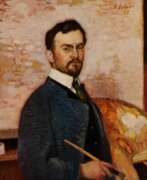

Fritz Erler was a German painter, graphic designer and scenic designer. Although most talented as an interior designer, he is perhaps best remembered for several propaganda posters he produced during World War I.
During the National Socialist period Erler's portraits of Adolf Hitler, Franz von Epp, and Wilhelm Frick were very remunerative.


Walter Firle was a German painter of the late nineteenth and first third of the twentieth centuries. He is known as a portrait and genre painter.
Firle was the author of a number of genre paintings and paintings on religious themes. Among his famous portraits are depictions of royalty, nobility, and famous personalities, including Prince Regent Luitpold of Bavaria, Ludwig III (King of Bavaria), and German Reich President Paul von Hindenburg. Several of his works were acquired by the National Gallery of Berlin. A portrait of Ludwig III was featured on a series of Bavarian stamps.
Firle was a professor at the Academy of Fine Arts in Munich and a member of the Munich Artists' Association.
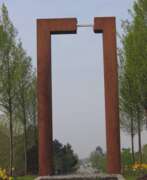

Kurt Fleckenstein is a German artist/sculptor associated with land art, minimal art and installation art. Fleckenstein was born in Heddesheim near Mannheim in Baden-Württemberg. His earlier career in landscape architecture, regional planning and horticultural art led to the establishment of several architectural studios in Germany, Austria and Poland. Since 2003 he has worked as a freelance artist with a focus on spatial objects and installations in exhibition centres and public open space. His provocative art form is designed to charm, irritate and challenge the viewer to question and compare “idealism with realism” on major social, cultural, economic and environmental issues. Fleckenstein now divides his home and work life between Mannheim, Germany and Wroclaw, Poland.
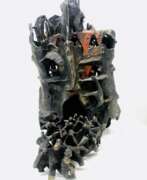

Tadeusz Foltyn was a Polish painter and sculptor.
In his works, the artist worked with various materials (bronze, iron and stone) to which he added paint. He achieved a dark and mysterious result, sometimes even causing destruction by depicting silhouettes, animals or buildings.
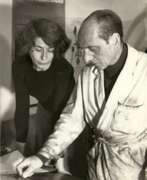

Johnny Friedlaender was a leading German/French 20th-century artist, whose works have been exhibited in Germany, France, Netherlands, Italy, Japan and the United States. He has been influential upon other notable artists, who were students in his Paris gallery. His preferred medium of aquatint etching is a technically difficult artistic process, of which Friedlaender has been a pioneer.


Hermann Johann Ernst Gemmel was a German architect and artist of the mid-nineteenth century. He is known as an architectural painter and educator.
Hermann Gemmel studied painting at the Berlin Academy of Fine Arts and began to specialize in architectural painting, depicting mainly architectural sites in East Prussia and Italy. These paintings of his are of great historical value today. In 1855 he became professor of perspective and architecture at the Königsberg Academy of Arts.


Stefan Gierowski was a Polish painter and an avant garde artist of post-war Poland.
For many years he was a professor at the Academy of Fine Arts in Warsaw where he earned numerous distinctions. He abandoned representational and realist painting midway through the 1950s and devoted himself entirely to abstract and optical effects. Acknowledging the concreteness of materials and colors, the artist, by his own admission, is mostly intrigued by the dual nature of light, how light is enclosed within a painting and yet somehow escapes it. According to the artist, each painting has a structure and a framework based on physical laws until it leaves the studio and becomes an enigma, at the disposition of the viewer, who discerns its content through a combination of emotional response and introspection. His paintings hang in major galleries in both Europe and the United States and in many countries throughout the world.
